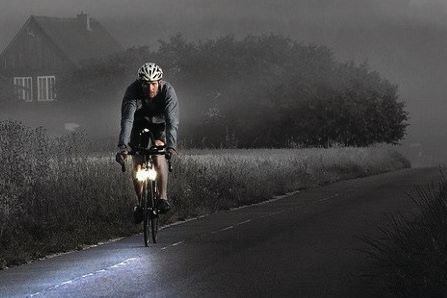Frictionless energy
Evan Zabawski | TLT From the Editor December 2015
A revolutionary dynamo illuminates the road.

What piqued my interest was that the system was powered by a contactless and frictionless dynamo.
I REALLY ENJOY RIDING MY MOUNTAIN BIKE, though it has been years since I rode daily. Back then I would commute about 18 km (11 miles) to and from work during the week, and at this time of the year that meant riding in the dark in both directions. Calgary has an amazing pathway system to circumvent riding on most roads, but one thing it doesn’t have is its own lighting; that is up to the cyclist.
One of the great pleasures I took in riding was the challenge of besting the trip time. There was only so much I could do to alter the route, so I focused on the setup and maintenance of the bike. Changing the chain lubricant to a penetrating wax produced noticeable results, as did keeping the tires properly inflated. Replacing derailleur wheel bushings and manually adjusted wheel and bottom bracket ball bearings with sealed roller bearings dropped a percent or two off the ride time.
One significant area for increased efficiency was to reduce the rotational weight of the wheels. Changing to custom-built wheels that used lightweight metals in the hub and tapered gauge spokes, as well as replacing steel beaded tires with Kevlar® folding tires, I was able to cut nearly 10% off my time.
Shedding weight elsewhere made marginal improvements, so I stripped the bike of all nonessentials (water bottle holder) and replaced essential parts with lighter versions (mounted reflectors with reflective stickers, steel parts with titanium). Performing this kind of task without any gain in performance results in other cyclists referring to you as a weight weenie. Occasionally I would be forced to add weight for comfort (fenders for the rainy/snowy days) and safety—namely lighting.
The lighting system I had then was a single halogen bulb powered by a battery pack that needed daily charging; it weighed just over 500 g (18 oz.). It served me well, but when I started working from home it was no longer used. Years of neglect have rendered the battery unable to take a charge, and a replacement is not available. I was thinking about getting a new one when a crowd-funded bicycle lighting system caught my eye last year.
What initially piqued my interest was that the system was powered by a dynamo, meaning no heavy battery was required. Now this is not a novel idea in it and of itself, but when the dynamo is also contactless and frictionless it is revolutionary (pun intended)! Dirk Strothmann of Magnic Light has created a compact dynamo comprised of strong magnets (positioned near the wheel rim) to generate the current to power the LED lights.
An on-board processor ensures the light intensity does not vary with wheel speed, and a capacitor ensures the lights stay on for a short period when the bike has stopped. The cherry on top is that each light is a mere 62 g (2.18 oz.).
My bike now boasts twin headlights and a taillight that light up within the first revolution—without a draw of energy from me or my bike—and a third of the weight of my old single headlight. The convenience of not having any cords to deal with, neither between the dynamo and the light, nor charging cables, is a delight. And though I don’t ride every day, and hardly ever in the dark, having the equivalent of daytime running lights makes me feel a lot safer.
Certainly others have had similar ideas, and a slightly different approach out of Cambridge, Mass., is called the Copenhagen Wheel. It is a single-wheel replacement for bicycles and contains a hub-based dynamo to power itself, basically turning your pedal bike into an electric-assisted bike. Coupled with smart software, it detects when you are pedaling harder to provide a boost, which preserves the biking experience unlike a throttle control.
With so many net-zero energy improvements for bicycles, why not go for a ride?
 Evan Zabawski, CLS, is a business development/reliability specialist for ALS Tribology in Calgary, Alberta, Canada. You can reach him at evan.zabawski@alsglobal.com
Evan Zabawski, CLS, is a business development/reliability specialist for ALS Tribology in Calgary, Alberta, Canada. You can reach him at evan.zabawski@alsglobal.com.